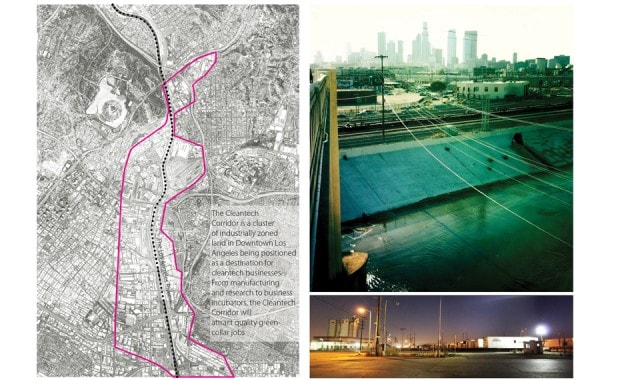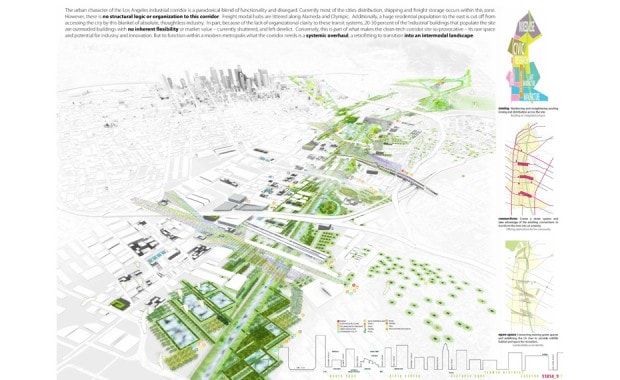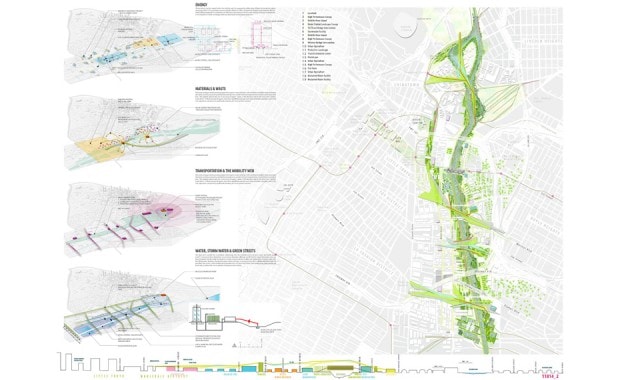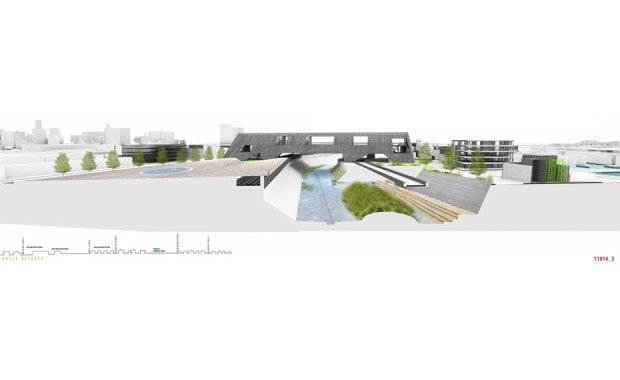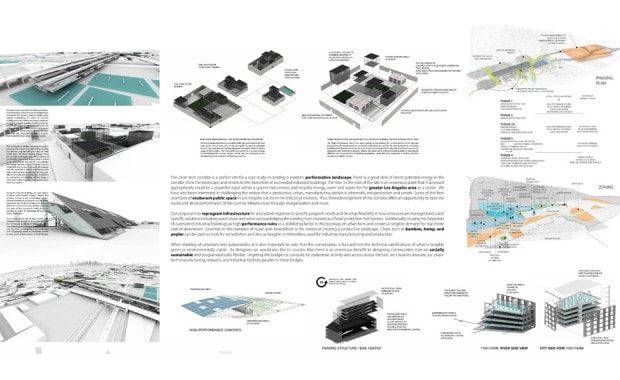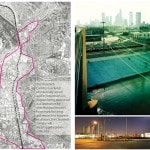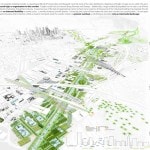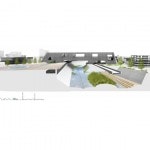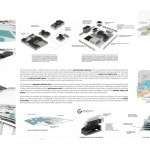Project: CleanTech Corridor
Location: Los Angeles, CA
Firm: Mia Lehrer + Associates
Year: 2010
Firm website: www.mlagreen.com
Project Description: The CleanTech Corridor is a 4 mile long district on the eastern edge of Downtown Los Angeles, stretching from the Los Angeles State Historic Park in the north, to the CleanTech Manufacturing Center in the South, and includes both the east and west banks of the channelized Los Angeles River.
The 2,000-acre development zone which encompasses a mix of industrial areas along the Los Angeles River was recently designated as the “Los Angeles Cleantech district”: the cornerstone of the Mayor’s vision to put Los Angeles at the forefront of the clean tech revolution and to transform the old, downtown industrial core of Los Angeles into an incubator for green jobs, technology and the growth of LA’s economy. The Clean Tech Corridor is envisioned to bring together researchers, designers and manufacturers dedicated to the development of clean technology products and solutions to climate change challenges.
To imagine the Cleantech district, the team answered an open ideas competition organized by SCI-Arc’s Future Initiatives program, the Mayors’ office and The Architect’s Newspaper.
To move beyond industrial use and create an integrated economic, residential, clean energy, and cultural engine for the city, the team, led by ML+A, explored high performance infrastructures and innovative landscape strategies to develop a highly contextual strategy based on re-using existing and under-utilized resources on the site. The team targeted three major urban infrastructural resources for reuse: the historic bridges crossing the Los Angeles River, the industrial urban fabric, and the LA River itself.
Hypothesis
The urban character of the Los Angeles industrial corridor is a paradoxical blend of functionality and disregard. Currently most of the cities distribution, shipping and freight storage occur within this zone. However, there is no structural logic or organization to this corridor. Freight modal hubs are littered along Alameda and Olympic. This blanket of industry is now a barrier between the Eastern Los Angeles community and downtown cutting off a large residential community from accessing the economic center of the city. Due to the lack of organizational clarity to these transit systems, 20-30 percent of the ‘industrial’ buildings that populate the site are outdated with no inherent flexibility or market value – currently shuttered, and left derelict. Conversely, this is part of what makes the clean-tech corridor site so provocative – its raw space and potential for industry and innovation. However, to function within a modern metropolis, the corridor needs a systemic overhaul, a retrofitting to transition into an intermodal landscape in which systems for energy creation (including solar arrays and hydroelectric power), waste management, transportation, and water runoff are integrated.
Solutions
1. The Bridges as destinations
The team chose to perceive the heroic and monumental bridges along the river as untapped opportunities for dynamic, flexible public space. Largely overlooked, the series of concrete bridges traversing the LA River are a major urban element that imposes a unique identity to the corridor. Major pieces of urban infrastructure, the bridges are an iconic remnant of a once useful and coherent transit system, before the freeways and cars, when the Los Angeles population moved in a less nodal, disparate fashion. The architectural bridges are programmed to integrate the community east of Los Angeles into the site, and formally stitch the two sides of the river.
2. The re-use of existing industrial fabric
The “high performance ruin” is one such strategy of remediating the current vacancy of the site and propagating the development of an interior small business corridor. By editing elements of existing building stock down to elemental form (and retaining a connection to the utility grid) new uses can be integrated with minimal investment. Ideally, the urban ruin is a flexible building platform allowing for different uses to be installed facilitating an adaptive, urban flexibility responsive to shifting business models and volatile markets.
3. The recalibrated LA river
The clean-tech corridor has a symbiotic relationship with the river channel and the periodic events of storm water. The district is re-envisioned as a water filter and percolation zone, while the river itself is redefined as a waterway to support ecological services and social recreation. Also addressing the current inadequate preparation for a 100 year event flood, flood pockets and open space have been introduced along the river as flood control devices to relieve the river in periods of excessive storm events.
Additional Information: Sponsored by SCI-Arc and The Architects Newspaper, 70 entries were received from architectural firms and students in 11 countries. The competition asked architects, landscape architects, designers, engineers, urban planners, students, and environmental professionals to create an innovative urban vision for the CleanTech Corridor. Entrants were encouraged to challenge conventional wisdom and move beyond industrial uses—creating an integrated economic, residential, clean energy, and cultural engine to re-invigorate the industrial district into a thriving mixed-use center. This design is a winning submission.
Project Team Members: Mia Lehrer + Associates (landscape architect)
Astrid Diehl
Zhihang Luo
Buro Happold (engineering)
Steve Chucovich
Ron Elad
Krista Flascha Laney
Jim Suhr (economist)
Elizabeth Timme (architect)
| previous project | next project |
